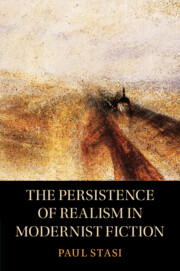Book contents
- The Persistence of Realism in Modernist Fiction
- The Persistence of Realism in Modernist Fiction
- Copyright page
- Contents
- Acknowledgments
- Introduction
- Chapter 1 Fables of Autonomy in Late James
- Chapter 2 “She Will Drown Me with Her”
- Chapter 3 “Innumerable Slight Changes”
- Chapter 4 “I Was Always Sentimental”
- Chapter 5 “He Forgot His History”
- Conclusion
- References
- Index
Chapter 3 - “Innumerable Slight Changes”
Historical Time and Social Reproduction in The Years
Published online by Cambridge University Press: 08 November 2022
- The Persistence of Realism in Modernist Fiction
- The Persistence of Realism in Modernist Fiction
- Copyright page
- Contents
- Acknowledgments
- Introduction
- Chapter 1 Fables of Autonomy in Late James
- Chapter 2 “She Will Drown Me with Her”
- Chapter 3 “Innumerable Slight Changes”
- Chapter 4 “I Was Always Sentimental”
- Chapter 5 “He Forgot His History”
- Conclusion
- References
- Index
Summary
Chapter 3 reads Virginia Woolf’s The Years as a domestic novel, even though it eschews all the landmarks – births, deaths, marriages and courtships – that typically animate the genre. If consent in nineteenth-century novels is typically doubled – consent to the marriage contract reading as consent to the social contract – I find, in Woolf, a critique of the whole idea, as she presents characters who are interpellated into a social system that predates them. Reading the novel alongside recent work in Social Reproduction Theory – and with the aid of Judith Butler’s notion of the “heterosexual matrix” – I show how Woolf situates her investigation of gender within a larger social totality even as she, characteristically, finds agency within its determining structures. Woolf’s domestic novel here transforms into its opposite – a historical novel – as she meditates on the passing of time and the way new social forms emerge out of conditions inherited from the past.
- Type
- Chapter
- Information
- The Persistence of Realism in Modernist Fiction , pp. 101 - 137Publisher: Cambridge University PressPrint publication year: 2022

